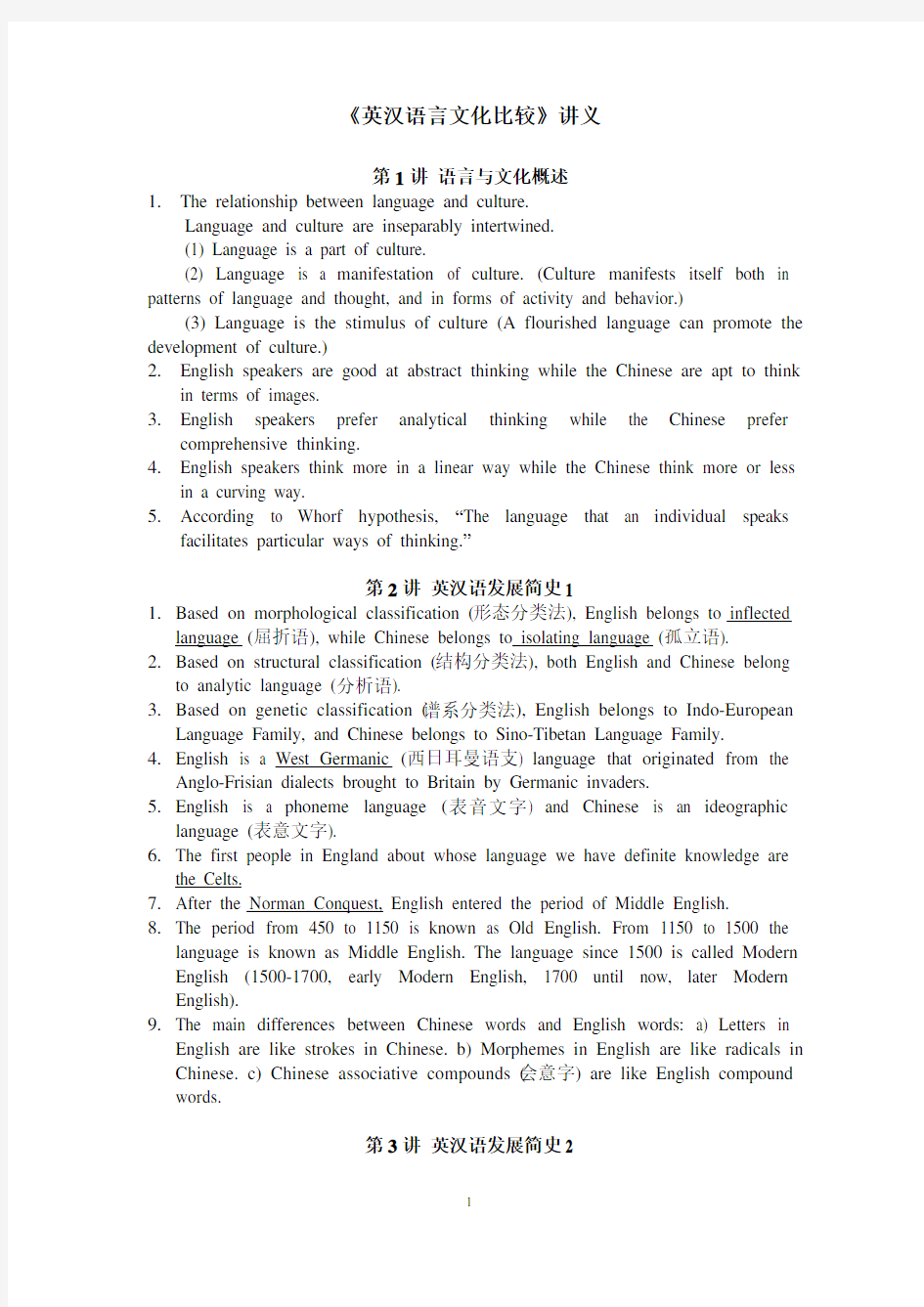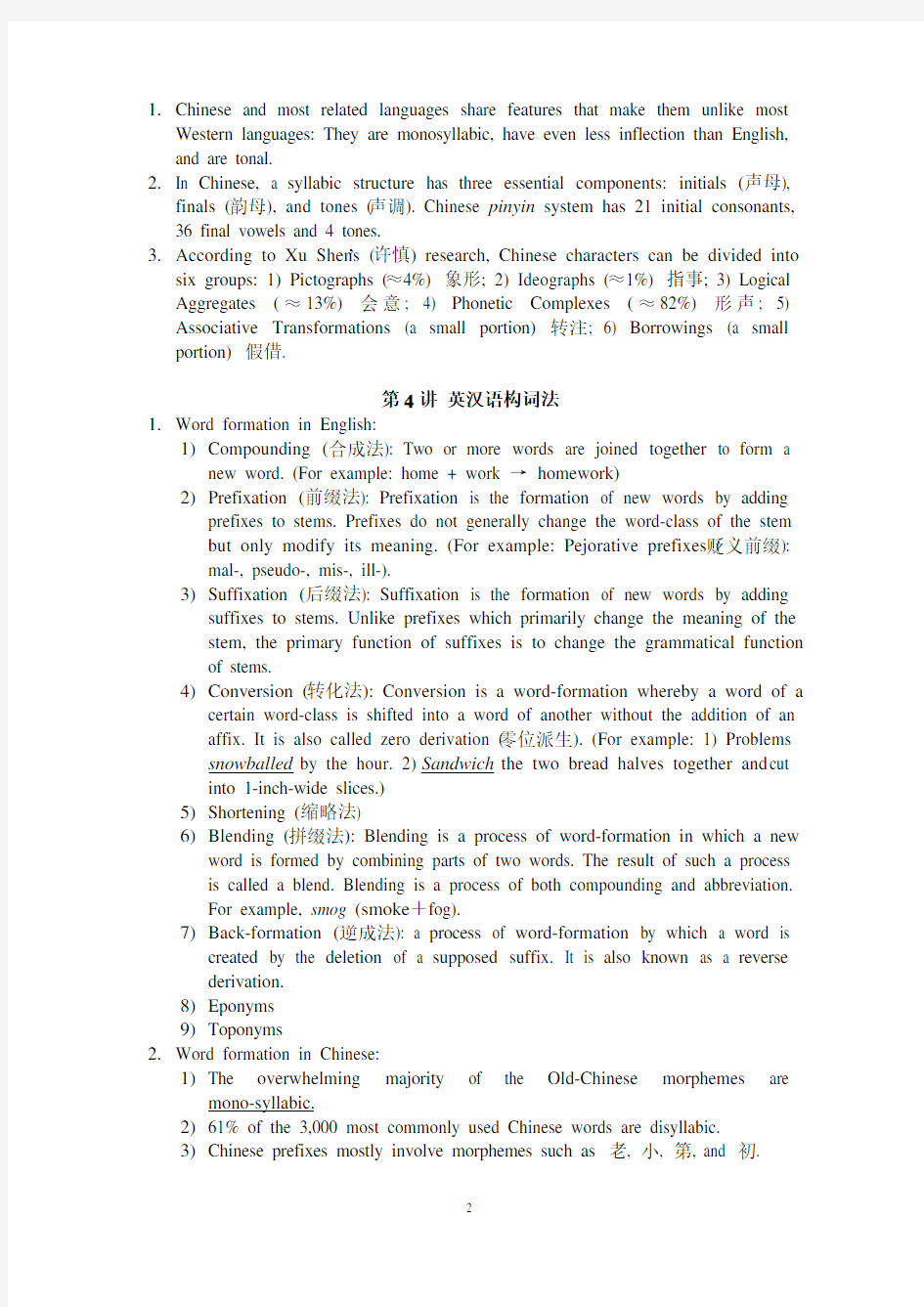英汉语言文化比较期末重点


《英汉语言文化比较》讲义
第1讲语言与文化概述
1.The relationship between language and culture.
Language and culture are inseparably intertwined.
(1) Language is a part of culture.
(2) Language is a manifestation of culture. (Culture manifests itself both in patterns of language and thought, and in forms of activity and behavior.)
(3) Language is the stimulus of culture (A flourished language can promote the development of culture.)
2.English speakers are good at abstract thinking while the Chinese are apt to think
in terms of images.
3.English speakers prefer analytical thinking while the Chinese prefer
comprehensive thinking.
4.English speakers think more in a linear way while the Chinese think more or less
in a curving way.
5.According to Whorf hypothesis, “The language that an individual speaks
facilitates particular ways of thinking.”
第2讲英汉语发展简史1
1.Based on morphological classification (形态分类法), English belongs to inflected
language (屈折语), while Chinese belongs to isolating language (孤立语).
2.Based on structural classification (结构分类法), both English and Chinese belong
to analytic language (分析语).
3.Based on genetic classification (谱系分类法), English belongs to Indo-European
Language Family, and Chinese belongs to Sino-Tibetan Language Family.
4.English is a West Germanic (西日耳曼语支) language that originated from the
Anglo-Frisian dialects brought to Britain by Germanic invaders.
5.English is a phoneme language (表音文字) and Chinese is an ideographic
language (表意文字).
6.The first people in England about whose language we have definite knowledge are
the Celts.
7.After the Norman Conquest, English entered the period of Middle English.
8.The period from 450 to 1150 is known as Old English. From 1150 to 1500 the
language is known as Middle English. The language since 1500 is called Modern English (1500-1700, early Modern English, 1700 until now, later Modern English).
9.The main differences between Chinese words and English words: a) Letters in
English are like strokes in Chinese. b) Morphemes in English are like radicals in Chinese. c) Chinese associative compounds (会意字) are like English compound words.
第3讲英汉语发展简史2
1.Chinese and most related languages share features that make them unlike most
Western languages: They are monosyllabic, have even less inflection than English, and are tonal.
2.In Chinese, a syllabic structure has three essential components: initials (声母),
finals (韵母), and tones (声调). Chinese pinyin system has 21 initial consonants,
36 final vowels and 4 tones.
3.According to Xu Shen’s (许慎) research, Chinese characters can be divided into
six groups: 1) Pictographs (≈4%) 象形; 2) Ideographs (≈1%) 指事; 3) Logical Aggregates (≈13%) 会意; 4) Phonetic Complexes (≈82%) 形声; 5) Associative Transformations (a small portion) 转注; 6) Borrowings (a small portion) 假借.
第4讲英汉语构词法
1.Word formation in English:
1)Compounding (合成法): Two or more words are joined together to form a
new word. (For example: home + work→homework)
2)Prefixation (前缀法): Prefixation is the formation of new words by adding
prefixes to stems. Prefixes do not generally change the word-class of the stem but only modify its meaning. (For example: Pejorative prefixes (贬义前缀): mal-, pseudo-, mis-, ill-).
3)Suffixation (后缀法): Suffixation is the formation of new words by adding
suffixes to stems. Unlike prefixes which primarily change the meaning of the stem, the primary function of suffixes is to change the grammatical function of stems.
4)Conversion (转化法): Conversion is a word-formation whereby a word of a
certain word-class is shifted into a word of another without the addition of an affix. It is also called zero derivation (零位派生). (For example: 1) Problems snowballed by the hour. 2) Sandwich the two bread halves together and cut into 1-inch-wide slices.)
5)Shortening (缩略法)
6)Blending (拼缀法): Blending is a process of word-formation in which a new
word is formed by combining parts of two words. The result of such a process is called a blend. Blending is a process of both compounding and abbreviation.
For example, smog (smoke+fog).
7)Back-formation (逆成法): a process of word-formation by which a word is
created by the deletion of a supposed suffix. It is also known as a reverse derivation.
8)Eponyms
9)Toponyms
2.Word formation in Chinese:
1)The overwhelming majority of the Old-Chinese morphemes are
mono-syllabic.
2)61% of the 3,000 most commonly used Chinese words are disyllabic.
3)Chinese prefixes mostly involve morphemes such as 老, 小, 第, and 初.
4)Some so-called Chinese suffixes are added as a way of nominalization, like
度, 性, etc.
第5讲英汉词语的文化内涵比较1
1.In Chinese, the word xīn (心) that primarily denotes the heart organ may also
refer to the “organ for thinking” and the “seat of thought and emotions”.
2.In contrast, according to the Western view, heart is seen as the center of
emotions/feelings and the head (the locus of the brain with which the mind is associated) as the center of thought.
3.Based on the metaphor “heart as a physical entity”, the following words are
formed in Chinese: 心房, 心窝, 心田, 心地, and 心弦.
4.Research proves that if a language only has two color words, they must be black
and white; if the language has the third color word, it must be red; if it has the fourth one, it must be yellow or green.
第6讲英汉词语的文化内涵比较2
1.Dog has a negative connotation in “a dog in the manger”.
2.Traditionally, people have talked about “fixed expressions”, stressing the
fixedness of these expressions, but corpus studies have shown that many of the phrases can actually be varied.
3.An idiom is a fixed or semi-fixed expression whose meaning cannot be deduced
from its parts. But very few idioms are 100% fixed.
第7讲英语抽象名词和汉语具体名词
1.The plural forms of abstract English nouns often have the function of
concretization, for example, ratings, attractions and breakdowns.
第8讲形合与意合
1.Hypotaxis (形合): The dependent or subordinate relationship of clauses with
connectives. For example: It was cold because the snows came.
2.Parataxis (意合): The arranging of clauses or phrases without connectives
showing the relations between them. For example: It was cold; the snows came.
第9讲英汉句法比较
1. A topic-prominent language is a language that organizes its syntax to emphasize
the topic–comment structure of the sentence. Chinese is considered to be a topic-prominent language, where the topic of the sentence takes precedence in the sentence.
2. A subject-prominent language (e.g. English) is a language in which the
grammatical units of subject and predicate (S V) are basic to the structure of sentences and in which sentences usually have subject-predicate structure.
第10讲英语被动句和汉语主动句
1.English uses far more passive sentences than Chinese./ Passive voice sentences
